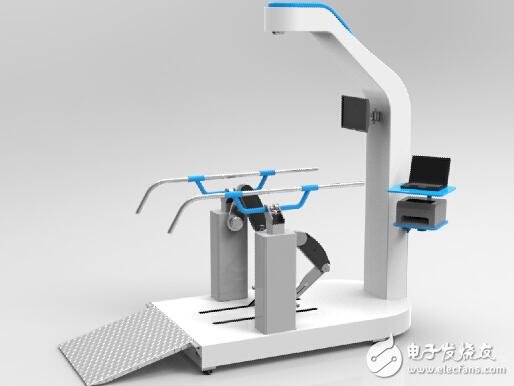It is estimated that in the next five years, the compound annual growth rate of generalized rehabilitation robots is about 37%, and the compound annual growth rate of rehabilitation robots is 21%. Faced with huge market prospects, a research and development team from Shanghai's exoskeleton robot has independently developed an upper limb intelligent rehabilitation robot that can improve the patient's rehabilitation quality in a “collaborative†way through auxiliary equipment other than body organs.
The aging population and the growth of chronically ill people have brought huge gaps in the supply of hospital rehabilitation equipment and service personnel. At the same time, artificial intelligence technology has driven the development of a variety of medical aids such as nursing robots and rehabilitation robots. Intelligent rehabilitation methods have gradually become the mainstream of rehabilitation equipment development.
According to the prediction of the famous American market research and consulting company GrandView Research, the market share of exoskeleton robots and auxiliary rehabilitation robots increased significantly from 2012 to 2022. It is estimated that in the next five years, the compound annual growth rate of generalized rehabilitation robots is about 37%, and the compound annual growth rate of rehabilitation robots is 21%.

Fourier Intelligent Technology is a research and development team of exoskeleton robots from Shanghai. Its self-developed new generation of upper limb intelligent rehabilitation robot Fourier M2 can provide various target-oriented training for patients with upper limb dysfunction by stimulating brain function reorganization. Specifically, it is to "help the rehabilitation patient to walk or complete a certain function through auxiliary equipment other than the body organs, and improve the patient's rehabilitation quality in a 'collaborative' manner." Gu Jie, founder & CEO of Fourier Smart Technology, said.
Rehabilitation robot is a combination of robot technology and medical technology. Its research can be traced back to the 1980s. Mike Topping in the United Kingdom and Manous Technical Department in the Massachusetts Institute of Technology are among the companies and institutions that have entered the research of assisted rehabilitation robots earlier. In addition, Israel's Rewalk RoboTIcs and Japan's Cyberdyne are star teams in the field of exoskeleton robots.
"The technical principle of our exoskeleton robot is very different from these ones." Gu Jie said that the biggest feature of the Fourier M2 is the realization of force feedback. "For the patient, there is an additional sensory dimension for the doctor. In other words, the rehabilitation program can be constantly adjusted and optimized by knowing the patient's intentions.
The tactile robot M2 currently offers four training modes for patients including assist, active, passive and resistive. It can help soft-sick patients (pediatric cerebral palsy, stroke hemiplegia, spinal paraplegia, amputation), nervous system diseases (stroke, cerebral infarction, etc.) or bone injury patients, in the visual, listening, touch multi-dimensional interactive game scene, simulate each The mechanical feedback in real life enables the patient to receive the corresponding main force through the actual main power and actively participate in the rehabilitation training.
Today, Fu Liye Intelligent Technology has established cooperation with Shanghai Huashan Hospital and Jiangsu Provincial People's Hospital. After pre-clinical testing, the products have been optimized in terms of efficiency and safety. Through continuous iteration, the market has been launched on December 2, 2016. The price is about one-third of similar products abroad.
It is worth mentioning that the M2 has a unique intelligent self-learning function. The therapist can customize the targeted exercise prescription according to the user's different conditions, and save the prescription in the system or exercise for the patient to use when training. In terms of safety, this product automatically recognizes and enters the 痉挛 protection mode when it is paralyzed to the patient.
Fourier Intelligent Technology currently has a team size of more than 20 people, of which 2/3 are technical R&D personnel, from robotics and biomedicine. Founder Gu Jie graduated from the Department of Power Machinery of Shanghai Jiaotong University. CTO Xu Zhenhua is a teammate who met in the Jiaotong Robotics Competition. The two formed the Haohe Robotics Company in 2012 and led the team to complete the development and market of Flexbot rehabilitation robots. Turn.
In July 2015, Fourier Intelligent Technology won the investment of 8 million angels from IDG Capital and Zhangjiang Ketou. In September 2016, the company acquired 15 million Pre-A rounds of volcanic stone capital. According to Liu Kai, vice president of volcanic stone investment, Fu Liye Intelligent Technology not only has the technology accumulation of deep-cultivation robots for many years, but also the founding team has rich management experience, and has the ability to quickly and iteratively productize and put into market operation. .
At present, the next-generation exoskeleton robot developed by Fourier Intelligent Technology has completed the prototype model and is expected to be released in late March this year, mainly for patients with walking dysfunction.
A modern gel battery (also known as a gel cell) is a VRLA battery with a gelified electrolyte; the sulfuric acid is mixed with fumed silica, which makes the resulting mass gel like and immobile. Unlike a flooded wet cell lead-acid battery, these batteries do not need to be kept upright.
Gel Battery 12V 200Ah,Gel Battery,Gel Battery 12V 150Ah,Gel Battery Solar
Shenzhen Glida Electronics Co., Ltd. , https://www.szglida.com